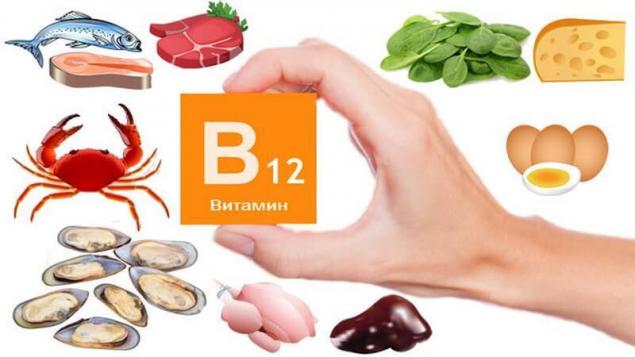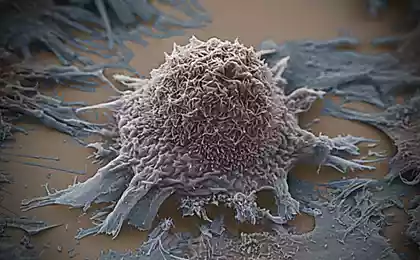675
Vitamin B12 deficiency, as manifested and what are the risks
In 1855, English physician T. Addison, and in 1872, the German physician A. Bermar described the disease called malignant (pernicious) anemia (PA). It was considered contagious and incurable and in its long history has claimed many hundreds of thousands of lives. It was a terrible disease that affects not only bone marrow but also digestive, and nervous system.
It is not surprising that when Whipple, Minot and Murphy (1926) announced that the PA is treated by the introduction in the diet of animals and humans of raw liver, in 1934 they received the Nobel prize. But the substance contained in the liver and rescued from PA, for a long time could not.
Only in 1948, American and British scientists independently of each allocated red crystals of a substance to which was given the name "vitamin B12".

To obtain 1 mg of B12 it took to process tons of raw materials, and to decipher its chemical structure was only in 1955 when the joint work of physicists and chemists. This was the first test of the definition of the structure of matter using a new method — x-ray analysis. Mathematicians produced more than 10 million operations. Only in 1973, after a full examination of the structure of B12 was able to synthesize artificial vitamin.
Solving the problem of the causes of PA, humanity took the B12 in the direction. Despite thousands of scientific papers on the indispensable role of B12 in other processes, it remained for many just "cause of anemia," but "trivial."
Its functions B12 performs with two active ingredients — methylcobalamin (MC) and deoxyadenosylcobalamin (DOAK). MK is the main form of vitamin contained in breast milk, human blood plasma, passing to the fetus through the placental barrier. The level of MK in the blood of the umbilical vein of a newborn is much higher than in the blood of the mother that shows the importance of B12 for the development of the fetus.
MK deficiency leads to disruption of DNA synthesis and all formed elements of blood (red and white spheres, platelets). Tissues receive less oxygen, atrophy, reduced their capacity for healing, regeneration and resistance to infections, altered blood viscosity. MK is able to neutralize mercury and lead, reducing their toxicity.
The deficit DOAK leads to disruption of metabolism of fatty acids, resulting in the body of accumulated toxic organic acids and developed degeneration of nerves and spinal cord lesion — funicular myelosis.
B12 is synthesized in nature by micro-organisms of the soil, the inhabitants of root crops and legumes, and is present in muscles and parenchymatous tissues of animals feeding on these plants. The person gets vitamin B12 from animal food.
In order for B12 could be absorbed in the body, which occurs at the end of the small intestine, it needs to connect to in the stomach with the so-called castle's intrinsic factor (VF), which is secreted by the parietal cells of the stomach wall (the same that secrete acid). VF carries B12 to the place of suction and ensures the supply to jejunum 90% of the ingested vitamin.
In children common congenital deficiency or functional deficiency of VF. To the metabolic disorder of vitamin B12 lead and congenital enzymopathies, which blocks the conversion of vitamin B12 in the MC and DOAK form.
For absorption of B12 from the gut need calcium ions, which must come from food. The lack of acidity, which is observed in chronic pancreatitis, gastritis, medication for heartburn, etc., may interfere with the absorption of B12.
Unused B12 excreted in the bile, which creates the possibility of its reabsorption in the blood deficiency of food. After cholecystectomy this process is disrupted and B12 is lost in the stool.
To expect and vitamin B12 in the gut microbes, especially putrefactive bacteria, fungi and parasites, "appetite" to B12 increases with increase in the diet sugars. So the seemingly harmless passion for sweet can lead to a vitamin deficiency, thanks to its own microflora.
PA can be congenital or acquired. The predominant age of patients older than 60 years, but a deficiency may occur in individuals of any age. In children with disorders of transport and metabolism of B12 clinical symptoms may appear after 6 months, but they are usually found to 3rd year of life. High frequency of blood group A in patients and their relatives and often the family nature of the disease indicate possible involvement of genetic factors in the development of "malignant anaemia".

The total content of B12 in humans, mainly in the liver, is 2-5 mg as the daily expenses are low (2-5 µg/day), in the case of a complete cessation of receipt of B12 in the body, the PA will develop in 3-4 years. But PA is already pronounced and irreversible deficiency, the frequency of which, as believe, among the elderly population in Europe is 1%. These statistics, however, included only patients with severe manifestations of PAS, suggesting a higher incidence.
Among the US population over the age of 60 prevalence undiagnosed PA, according to Dunn analysis of the literature, and averaged only 1.9% (2.7% of. in women, 1.4 percent for men). In extrapolating the study results to the General population, it turns out that unrecognized, PA has approximately 800 000 older Americans (E. Nurmuchametova).
Despite all the advances in modern medicine, the vitamin B12 are not uncommon. Its frequency increases with age.
Does he in the early stages?
Even the discoverer, PA Dr. T. Addison gave a list of symptoms of the growth of vitamin B12. First the person is concerned about the weakness, easy fatigue, reduced performance, headache, irritability. For more recent periods characterized by loss of appetite, memory impairment, and tinnitus. Patients report palpitations, dyspnea on exertion, pain in the heart, swelling in the legs.
This gives doctors reason to assume that patients with a cardiac pathology, such as ischemic heart disease. Patients usually full, with a puffy pale face. Include pigmentation of nails and skin folds or vitiligo. The language can be areas of inflammation, sometimes challenging the entire surface ("scalded" language), ulcers. Meal and medicine is accompanied by burning sensation and pain. Sometimes patients complain of a feeling of heaviness in the epigastric region, loss of appetite and irregularity.
Analysis of the gastric juice shows a decrease in or lack of hydrochloric acid and enzymes. Endoscopy revealed atrophy of the gastric mucosa. Histological examination reveals atypical mitoses and giant cells in the mucous membranes of the tongue, oral cavity, esophagus, stomach and intestines. Because the exfoliating epithelial cells do not regenerate, this leads to inflammatory and atrophic changes of the mucosa, which clinically manifested in the form of glossitis, stomatitis, esophagitis, gastritis and enteritis. The appointment of such patients preparations "heartburn" is not only not recommended, but also dangerous by its consequences — the development of the PA.
PA often develops on the background of pre-existing gastritis or gastric polyps, which once again shows the relationship of all things in Nature. It is believed that PA is the result of a chronic autoimmune damage to the gastric mucosa and, according to various authors, 2-10% accompanies cancer of the stomach. The results of a recent survey of a large number of people in Sweden and retrospective analysis of surveys of more than 30,000 veterans indicate that the risk of developing gastric cancer in patients with PA increases at least 2-3 times. Interesting fact that stomach cancer develops, usually within 1-2 years after the discovery of the PA.
At PA in 35-50% of cases are also observed antibodies to the thyroid and the pancreas. In elderly PA occurs most frequently in combination with other autoimmune disorders (rheumatoid arthritis, graves ' disease, hypothyroidism, hypoparathyroidism, Hashimoto's thyroiditis, diabetes, etc.), adrenal insufficiency, etc.
When B12 deficiencyoccurs degenerative processes in the membranes of peripheral nerves, spinal cord and brain. Some patients may mental changes: anxiety, confusion, depression, psychosis. Acute pain, heartburn, disorders of urination, changes in vision, hearing, taste, smell and behavior, frequent symptoms of PA are the consequence of nerve damage and brain. Neurological symptoms of B12 deficiency can occur without anemia.
Development of B12 deficiency contribute to celiac disease, cystic fibrosis, alcoholism, resection of the stomach and intestines, vegetarian diet without supplementation, certain medications (biguanide, phenylbutazone, aminosalicylic acid, Metformin, oral contraceptives, anticonvulsants (dilantin, mialin), prolonged thermal processing of food products.
Diagnosis of B12 deficiency is not always easy, since clinical manifestations early in the disease malespecific. Vitamin B12 deficiency is reliably set at a low level of B12 in blood plasma (<100 PG/ml). However, in many cases of beriberi level in the plasma in normal range.

Importantly, among patients with clinical severe vitamin deficiency quite a few people have changes in peripheral blood. Doctors often do not have sufficient reason to suspect the patient is having a PA, if you don't remember about the "deceit" B12.
Diagnosis is difficult due to the fact that patients with any anemia often prescribed pills B12 and folic acid. This eliminates the characteristic features of B12-deficiency anemia. Therefore, it is impossible to start treatment with vitamin B12 before diagnosis. In those cases where it was initiated treatment with vitamin B12, the diagnosis can be made only in the study of absorption of labeled vitamin B12.
Important for the diagnosis of PA, bone marrow biopsy is often also nonspecific. Characteristic of PA is the presence of punctate instead of the normal precursor cells of erythrocytes of abnormal large cells called megaloblasts, are not able to become red blood cells, and die in the bone marrow, and defeat all the germs of blood.
Avitaminosis B12 should stand first in the list of diseases that must be differentiated from the syndrome of myelodysplasia bone marrow and senile dementia.
Treatment only at first glance simple — B12. The question is why you have a deficit, what form of B12 it shows you how to "deliver" B12 necessary for you how to make it "work" and how long do you have to take it. Pills B12 PA is not cured. Injections B12 preparations are made according to a certain scheme in combination with other vitamins and minerals, select a doctor.
Recall that B12 deficiency causes irreversible changes in the brain, therefore the treatment must be persistent and initiated as early as possible. Signs of CNS can be preserved, if a patient's treatment was initiated 6 months or more from the onset of the disease.
Recent studies show that the use of some forms of B12 also helps in the treatment of autism, cirrhosis, hepatitis, psoriasis, fractures, premature aging and many other conditions with which we do not usually associate the possibility of beriberi.

Vitamin B12 is required for the following conditions and diseases:
Remember, self-life-threatening, for advice about the use of any medication, contact your doctor.
Author: Elena K., Coles, M. D., doctor of medical Sciences, Professor
Also interesting: Vitamin B11 to fight obesity and not only
Vitamin B12 — interaction, daily dose, indication
P. S. And remember, just changing your mind — together we change the world! ©
Source: www.elinahealthandbeauty.com/Articles_of_Doctor_Elena_Koles.htm#doc1
It is not surprising that when Whipple, Minot and Murphy (1926) announced that the PA is treated by the introduction in the diet of animals and humans of raw liver, in 1934 they received the Nobel prize. But the substance contained in the liver and rescued from PA, for a long time could not.
Only in 1948, American and British scientists independently of each allocated red crystals of a substance to which was given the name "vitamin B12".

To obtain 1 mg of B12 it took to process tons of raw materials, and to decipher its chemical structure was only in 1955 when the joint work of physicists and chemists. This was the first test of the definition of the structure of matter using a new method — x-ray analysis. Mathematicians produced more than 10 million operations. Only in 1973, after a full examination of the structure of B12 was able to synthesize artificial vitamin.
Solving the problem of the causes of PA, humanity took the B12 in the direction. Despite thousands of scientific papers on the indispensable role of B12 in other processes, it remained for many just "cause of anemia," but "trivial."
Its functions B12 performs with two active ingredients — methylcobalamin (MC) and deoxyadenosylcobalamin (DOAK). MK is the main form of vitamin contained in breast milk, human blood plasma, passing to the fetus through the placental barrier. The level of MK in the blood of the umbilical vein of a newborn is much higher than in the blood of the mother that shows the importance of B12 for the development of the fetus.
MK deficiency leads to disruption of DNA synthesis and all formed elements of blood (red and white spheres, platelets). Tissues receive less oxygen, atrophy, reduced their capacity for healing, regeneration and resistance to infections, altered blood viscosity. MK is able to neutralize mercury and lead, reducing their toxicity.
The deficit DOAK leads to disruption of metabolism of fatty acids, resulting in the body of accumulated toxic organic acids and developed degeneration of nerves and spinal cord lesion — funicular myelosis.
B12 is synthesized in nature by micro-organisms of the soil, the inhabitants of root crops and legumes, and is present in muscles and parenchymatous tissues of animals feeding on these plants. The person gets vitamin B12 from animal food.
In order for B12 could be absorbed in the body, which occurs at the end of the small intestine, it needs to connect to in the stomach with the so-called castle's intrinsic factor (VF), which is secreted by the parietal cells of the stomach wall (the same that secrete acid). VF carries B12 to the place of suction and ensures the supply to jejunum 90% of the ingested vitamin.
In children common congenital deficiency or functional deficiency of VF. To the metabolic disorder of vitamin B12 lead and congenital enzymopathies, which blocks the conversion of vitamin B12 in the MC and DOAK form.
For absorption of B12 from the gut need calcium ions, which must come from food. The lack of acidity, which is observed in chronic pancreatitis, gastritis, medication for heartburn, etc., may interfere with the absorption of B12.
Unused B12 excreted in the bile, which creates the possibility of its reabsorption in the blood deficiency of food. After cholecystectomy this process is disrupted and B12 is lost in the stool.
To expect and vitamin B12 in the gut microbes, especially putrefactive bacteria, fungi and parasites, "appetite" to B12 increases with increase in the diet sugars. So the seemingly harmless passion for sweet can lead to a vitamin deficiency, thanks to its own microflora.
PA can be congenital or acquired. The predominant age of patients older than 60 years, but a deficiency may occur in individuals of any age. In children with disorders of transport and metabolism of B12 clinical symptoms may appear after 6 months, but they are usually found to 3rd year of life. High frequency of blood group A in patients and their relatives and often the family nature of the disease indicate possible involvement of genetic factors in the development of "malignant anaemia".

The total content of B12 in humans, mainly in the liver, is 2-5 mg as the daily expenses are low (2-5 µg/day), in the case of a complete cessation of receipt of B12 in the body, the PA will develop in 3-4 years. But PA is already pronounced and irreversible deficiency, the frequency of which, as believe, among the elderly population in Europe is 1%. These statistics, however, included only patients with severe manifestations of PAS, suggesting a higher incidence.
Among the US population over the age of 60 prevalence undiagnosed PA, according to Dunn analysis of the literature, and averaged only 1.9% (2.7% of. in women, 1.4 percent for men). In extrapolating the study results to the General population, it turns out that unrecognized, PA has approximately 800 000 older Americans (E. Nurmuchametova).
Despite all the advances in modern medicine, the vitamin B12 are not uncommon. Its frequency increases with age.
Does he in the early stages?
Even the discoverer, PA Dr. T. Addison gave a list of symptoms of the growth of vitamin B12. First the person is concerned about the weakness, easy fatigue, reduced performance, headache, irritability. For more recent periods characterized by loss of appetite, memory impairment, and tinnitus. Patients report palpitations, dyspnea on exertion, pain in the heart, swelling in the legs.
This gives doctors reason to assume that patients with a cardiac pathology, such as ischemic heart disease. Patients usually full, with a puffy pale face. Include pigmentation of nails and skin folds or vitiligo. The language can be areas of inflammation, sometimes challenging the entire surface ("scalded" language), ulcers. Meal and medicine is accompanied by burning sensation and pain. Sometimes patients complain of a feeling of heaviness in the epigastric region, loss of appetite and irregularity.
Analysis of the gastric juice shows a decrease in or lack of hydrochloric acid and enzymes. Endoscopy revealed atrophy of the gastric mucosa. Histological examination reveals atypical mitoses and giant cells in the mucous membranes of the tongue, oral cavity, esophagus, stomach and intestines. Because the exfoliating epithelial cells do not regenerate, this leads to inflammatory and atrophic changes of the mucosa, which clinically manifested in the form of glossitis, stomatitis, esophagitis, gastritis and enteritis. The appointment of such patients preparations "heartburn" is not only not recommended, but also dangerous by its consequences — the development of the PA.
PA often develops on the background of pre-existing gastritis or gastric polyps, which once again shows the relationship of all things in Nature. It is believed that PA is the result of a chronic autoimmune damage to the gastric mucosa and, according to various authors, 2-10% accompanies cancer of the stomach. The results of a recent survey of a large number of people in Sweden and retrospective analysis of surveys of more than 30,000 veterans indicate that the risk of developing gastric cancer in patients with PA increases at least 2-3 times. Interesting fact that stomach cancer develops, usually within 1-2 years after the discovery of the PA.
At PA in 35-50% of cases are also observed antibodies to the thyroid and the pancreas. In elderly PA occurs most frequently in combination with other autoimmune disorders (rheumatoid arthritis, graves ' disease, hypothyroidism, hypoparathyroidism, Hashimoto's thyroiditis, diabetes, etc.), adrenal insufficiency, etc.
When B12 deficiencyoccurs degenerative processes in the membranes of peripheral nerves, spinal cord and brain. Some patients may mental changes: anxiety, confusion, depression, psychosis. Acute pain, heartburn, disorders of urination, changes in vision, hearing, taste, smell and behavior, frequent symptoms of PA are the consequence of nerve damage and brain. Neurological symptoms of B12 deficiency can occur without anemia.
Development of B12 deficiency contribute to celiac disease, cystic fibrosis, alcoholism, resection of the stomach and intestines, vegetarian diet without supplementation, certain medications (biguanide, phenylbutazone, aminosalicylic acid, Metformin, oral contraceptives, anticonvulsants (dilantin, mialin), prolonged thermal processing of food products.
Diagnosis of B12 deficiency is not always easy, since clinical manifestations early in the disease malespecific. Vitamin B12 deficiency is reliably set at a low level of B12 in blood plasma (<100 PG/ml). However, in many cases of beriberi level in the plasma in normal range.

Importantly, among patients with clinical severe vitamin deficiency quite a few people have changes in peripheral blood. Doctors often do not have sufficient reason to suspect the patient is having a PA, if you don't remember about the "deceit" B12.
Diagnosis is difficult due to the fact that patients with any anemia often prescribed pills B12 and folic acid. This eliminates the characteristic features of B12-deficiency anemia. Therefore, it is impossible to start treatment with vitamin B12 before diagnosis. In those cases where it was initiated treatment with vitamin B12, the diagnosis can be made only in the study of absorption of labeled vitamin B12.
Important for the diagnosis of PA, bone marrow biopsy is often also nonspecific. Characteristic of PA is the presence of punctate instead of the normal precursor cells of erythrocytes of abnormal large cells called megaloblasts, are not able to become red blood cells, and die in the bone marrow, and defeat all the germs of blood.
Avitaminosis B12 should stand first in the list of diseases that must be differentiated from the syndrome of myelodysplasia bone marrow and senile dementia.
Treatment only at first glance simple — B12. The question is why you have a deficit, what form of B12 it shows you how to "deliver" B12 necessary for you how to make it "work" and how long do you have to take it. Pills B12 PA is not cured. Injections B12 preparations are made according to a certain scheme in combination with other vitamins and minerals, select a doctor.
Recall that B12 deficiency causes irreversible changes in the brain, therefore the treatment must be persistent and initiated as early as possible. Signs of CNS can be preserved, if a patient's treatment was initiated 6 months or more from the onset of the disease.
Recent studies show that the use of some forms of B12 also helps in the treatment of autism, cirrhosis, hepatitis, psoriasis, fractures, premature aging and many other conditions with which we do not usually associate the possibility of beriberi.

Vitamin B12 is required for the following conditions and diseases:
- Strengthening the immune system
- Chronic fatigue syndrome
- Atopic dermatitis
- Allergy, Eczema
- Asthma
- Neuralgia, polyneuropathy, radiculopathy.
- Delay mental and physical development
- Hepatitis, fatty liver
- Adrenal insufficiency
- Cirrhosis of the liver, alcoholism
- Pancreatitis, C-m Zollinger-Ellison
- Angina, hypertension
- Attention deficit disorder
- Hyperactivity
- Autism
- Alzheimer's Disease
- Multiple sclerosis
- Psychosis, dementia
- Apathy, depression
- Atherosclerosis
- Ulcerative colitis
- Crohn's Disease
- Celiac disease
- Gastritis
- Weight loss, anorexia
- Mucoviscidose
- Amyloidosis
- Rheumatoid arthritis
- Osteoarthritis, low back pain
- Osteoporosis
- Diabetes
- Thyroid disease
- Heavy menstrual bleeding
- Cervical dysplasia
- Seboreyny dermatitis
- Psoriasis, photodermatosis
- Herpes, shingles
- Aphthous stomatitis, glossitis
- HIV and AIDS
- Non-healing wounds and fractures
- Heavy metal poisoning
- Resection of stomach, bowel
- Diverticulosis
- Lymphoma.published
Remember, self-life-threatening, for advice about the use of any medication, contact your doctor.
Author: Elena K., Coles, M. D., doctor of medical Sciences, Professor
Also interesting: Vitamin B11 to fight obesity and not only
Vitamin B12 — interaction, daily dose, indication
P. S. And remember, just changing your mind — together we change the world! ©
Source: www.elinahealthandbeauty.com/Articles_of_Doctor_Elena_Koles.htm#doc1
Where the soul hides its sufferings: 7 classical psychosomatic diseases
Veranda at the cottage: the best ideas for decorating























